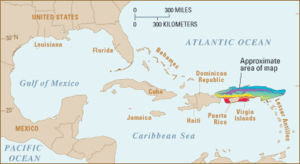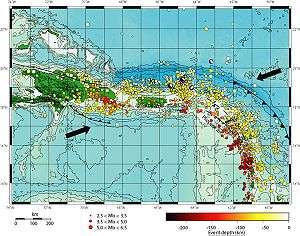Puerto Rico Trench
The Puerto Rico Trench is located on the boundary between the Caribbean Sea and the Atlantic Ocean. The oceanic trench, the deepest in the Atlantic, is associated with a complex transition between the Lesser Antilles subduction zone to the south and the major transform fault zone or plate boundary, which extends west between Cuba and Hispaniola through the Cayman Trough to the coast of Central America.

The trench is 800 kilometres (497 mi) long and has a maximum depth of 8,376 metres (27,480 ft)[1] or 5.20 miles. This constitutes the single deepest point in the Atlantic Ocean. This point is commonly referred to as the Milwaukee Deep, with the Brownson Deep naming the seabed surrounding it.[2] However, more recently, the latter term has also been used interchangeably with the former to refer to this point.[3][4][5] The exact point was identified by the DSSV Pressure Drop using a state-of-the-art Kongsberg EM124 multibeam sonar in 2018, and then directly visited and its depth verified by the manned submersible Deep-Submergence Vehicle DSV Limiting Factor (a Triton 36000/2 model submersible) piloted by Victor Vescovo.[6][7][8]
Scientific studies have concluded that an earthquake occurring along this fault zone could generate a significant tsunami.[9] The island of Puerto Rico, which lies immediately to the south of the fault zone and the trench, suffered a destructive tsunami soon after the 1918 San Fermín earthquake.
Geology
The Puerto Rico Trench is located at a boundary between two plates that pass each other along a transform boundary with only a small component of subduction. The Caribbean Plate is moving to the east while the North American Plate is moving to the west. The North American Plate is being subducted by the Caribbean Plate obliquely at the trench while to the southeast, the South American Plate is being more directly subducted along the Lesser Antilles subduction zone. This subduction zone explains the presence of active volcanoes over the southeastern part of the Caribbean Sea. Volcanic activity is frequent along the island arc southeast from Puerto Rico to the coast of South America.
Puerto Rico, the United States Virgin Islands, British Virgin Islands, and the Dominican Republic do not have active volcanoes; however, they are at risk from earthquakes and tsunamis. The Puerto Rico Trench has produced earthquakes greater than magnitude 8.0 and is considered capable of continuing to do so.[10][11]
According to NASA, beneath the trench is a mass so dense it has a gravitational pull on the surface of the ocean, causing it to dip somewhat. It also has a negative effect on the accuracy of navigational instruments.[12]
Public awareness
Knowledge of the earthquake and tsunami risks has not been widespread among the general public of the islands located near the trench. Since 1988, the Puerto Rican Seismic Society has been trying to use the Puerto Rican media to inform people about a future earthquake that could result in a catastrophic tragedy.
Following the 2004 tsunami that affected more than forty countries in the Indian Ocean, many more people now fear the consequences that such an event would bring to the Caribbean. Local governments have begun emergency planning. In the case of Puerto Rico and the U.S. Virgin Islands, the United States government has been studying the problem for years.[13] It is increasing its seismic investigations and developing tsunami warning systems.
Earthquake history

On 11 October 1918, the western coast of Puerto Rico was hit by a major earthquake which caused a tsunami. The 1918 earthquake was caused by an old left-lateral strike-slip fault near the Mona Passage. In 1953, Santo Domingo, Dominican Republic, was affected by the Santo Domingo earthquake. The actual subduction zone (Puerto Rico Trench) has not ruptured in over 200 years, which is a major concern to geophysicists, as they believe it may be due for a major event.
Puerto Rico has always been an area of concern to earthquake experts because, apart from the 1918 episode, there are frequent tremors in and around the island, indicating activity. A 1981 tremor was felt across the island, while another in 1985 was felt in the towns of Cayey and Salinas.
The January 13, 2014 M 6.4 earthquake north of Puerto Rico occurred as a result of oblique-thrust faulting. Preliminary faulting mechanisms for the event indicate it ruptured either a structure dipping shallowly to the south and striking approximately east-west, or a near-vertical structure striking northwest-southeast. At the location of this earthquake, the North America plate moves west-southwest with respect to the Caribbean plate at a velocity of approximately 20 mm/yr, and subducts beneath the Caribbean plate at the Puerto Rico Trench. The location, depth and mechanism of the earthquake are consistent with the event occurring on this subduction zone interface."[14]
| Location[13] | Year | M |
|---|---|---|
| Puerto Rico Trench | ||
| Anegada Trough | ||
| Mona Canyon | ||
| Mona Canyon | ||
| Dominican Republic | ||
| Dominican Republic | ||
| Puerto Rico Trench | ||
| Puerto Rico Trench | ||
| Muertos Trough |
Exploration
Several exploration cruises carried out by USGS in the Puerto Rico Trench have for the first time mapped the entire trench using ship mounted multibeam bathymetry.
The seafloor was visited for the first time by French bathyscaphe Archimède in 1964[15][16] and then by a robotic vehicle in 2012.[17] The most conspicuous aspect of the footage was the swarm of benthic amphipods. Some of these amphipods were collected by bait bags attached to the vehicle and were brought to the surface for further analysis. The samples recovered were Scopelocheirus schellenbergi, a species of lysianassid amphipod that have so far only been found in ultradeep trenches in the Pacific.[18]
Two invertebrate creatures were also observed in the video. One soft dark individual, estimated to be 10–20 cm (3.9–7.9 in) long, has been identified by Dr. Stace E. Beaulieu of Woods Hole Oceanographic Institution as a sea cucumber, tentatively assigned to genus Peniagone. The other individual, a small crustacean, is tentatively identified as a munnopsid isopod, based on morphology and similar walking and jumping movements observed for other hadal munnopsid isopods. Because these individual were not collected, it is not possible to obtain species-level identifications. However, these sightings likely exceed the deepest known records for genus Peniagone and family Munnopsidae.
Manned descent

The American explorer Victor Vescovo dived to the deepest point of the Puerto Rico Trench and therefore the Atlantic Ocean on 19 December 2018, as part of the Five Deeps Expedition. He reached a depth of 8,376 m (27,480 ft) ±5 m (16 ft) at 19°42'49" N, 67°18'39" W by direct CTD pressure measurements with the Deep-Submergence Vehicle DSV Limiting Factor (a Triton 36000/2 model submersible) and thus became the first person to reach the bottom of the Atlantic Ocean while also making the second-deepest recorded solo dive in history at that time.[19] Many media outlets referred to the deep as Brownson Deep,[20][21][22] in opposition to past references to the area, where the term Milwaukee Deep was used instead.
The operating area was surveyed by the support ship, the Deep Submersible Support Vessel DSSV Pressure Drop, with a Kongsberg SIMRAD EM124 multibeam echosounder system. The gathered data will be donated to the GEBCO Seabed 2030 initiative.[23][24] The dive was part of the Five Deeps Expedition. The objective of this expedition is to thoroughly map and visit the deepest points of all five of the world's oceans by the end of September 2019.[25][26]
References
- "Atlantic Ocean". Five Deeps Expedition. Retrieved 2020-01-24.
- Stewart, Heather Ann (October 2019). "The five deeps: The location and depth of the deepest place in each of the world's oceans". Earth-Science Reviews. 197:102896 – via ResearchGate.
- "Exploring the Deepest Points on Planet Earth". hydro-international.com. Retrieved 2020-01-24.
- "The last of the great explorers, The last of the great explorers". The Economist. ISSN 0013-0613. Retrieved 2020-01-24.
- Raza, Azra (2019-11-10). "The last of the great explorers". 3 Quarks Daily. Retrieved 2020-01-24.
- DSV Limiting Factor
- Dean, Josh (2018-12-21). "An inside look at the first solo trip to the deepest point of the Atlantic". Popular Science. Archived from the original on 2019-12-09. Retrieved 2018-12-22.
- "Deep Dive 1 Atlantic Ocean PUERTO RICO TRENCH". fivedeeps.com. Retrieved May 13, 2019.
- ten Brink, Uri. "Puerto Rico Trench 2003: Cruise Summary Results". National Oceanic and Atmospheric Administration. Retrieved 2011-09-11.
- "Earthquakes and Tsunamis in Puerto Rico and the U.S. Virgin Islands" (PDF). USGS. April 2001. Retrieved 11 January 2020.
USGS Fact Sheet FS–141–00
- "Major Caribbean Earthquakes And Tsunamis A Real Risk". ScienceDaily. 8 February 2005. Retrieved 11 January 2020.
The Puerto Rico Trench, which is capable of producing earthquakes of magnitude 7 to 8 or greater
- Nicks, Oran W., ed. (1970). "The Waters of Earth". This Island Earth. NASA. p. 53. LCCN 73608969. NASA SP-250.
Beneath this 5-mile-deep trough lies a mysterious mass so dense it deflects the pull of gravity, causes the ocean surface to dip a measurable amount, and throws navigators off course by falsifying the readings of their instruments.
- "Earthquakes and Tsunamis in Puerto Rico and the U.S. Virgin Islands" (PDF). U.S. Geological Survey Fact Sheet 141-00. April 2001. Archived (PDF) from the original on 2019-06-29. Retrieved 2011-09-11.
- M6.4 - 57km N of Hatillo, Puerto Rico, Earthquake Hazard Program, 2014-01-13 04:01:04 UTC, USGS
- Pérês, J.M. (1965). "Aperçu sur les résultats de deux plongées effectuées dans le ravin de Puerto-Rico par le bathyscaphe Archimède". Deep-Sea Research and Oceanographic Abstracts (in English and French). 12 (6): 883–891. Bibcode:1965DSROA..12..883P. doi:10.1016/0011-7471(65)90811-9.
- Cloud, Wallace (August 1964). "Jeeps in the Deep: Exploring 'Inner Space' and 4,500 Fathoms". Popular Science Monthly. Vol. 185 no. 2. p. 42. Retrieved 2018-12-23.
- Søreide, Fredrik (December 2012). "Ultradeep-Sea Exploration In the Puerto Rico Trench". Sea Technology. Vol. 53 no. 12. p. 54. Archived from the original on 2016-04-13. Retrieved 2019-12-08.
- Lacey, Nichola C.; Jamieson, Alan J.; Søreide, Fredrik (March 2013). "Successful Capture of Ultradeep Sea Animals From the Puerto Rico Trench". Sea Technology. Vol. 54 no. 3. pp. 19–21. Archived from the original on 2016-04-16.
- Brueck, Hilary (2018-12-20). "A $48 million submarine just took a record-breaking dive into the deepest corner of the Atlantic Ocean — 27,840 feet down". Business Insider. Archived from the original on 2019-12-09. Retrieved 2018-12-21.
- "Exploring the Deepest Points on Planet Earth". hydro-international.com. Retrieved 2020-01-24.
- "The last of the great explorers, The last of the great explorers". The Economist. ISSN 0013-0613. Retrieved 2020-01-24.
- Raza, Azra (2019-11-10). "The last of the great explorers". 3 Quarks Daily. Retrieved 2020-01-24.
- The Nippon Foundation-GEBCO Seabed 2030 Project
- "Major partnership announced between The Nippon Foundation-GEBCO Seabed 2030 Project and The Five Deeps Expedition". gebco.net. 11 March 2019. Retrieved June 19, 2019.
- "Home". fivedeeps.com. Retrieved January 9, 2019.
- Hydro International.com (18 June 2019). "Exploring the Deepest Points on Planet Earth". hydro-international.com. Retrieved June 20, 2019.
External links
- Mapping of the Puerto Rico Trench, the Deepest Part of the Atlantic, is Nearing Completion – United States Geological Survey
- Workshop Addresses Tsunami Hazard to Puerto Rico, the Virgin Islands, and Other Caribbean Islands – United States Geological Survey
- Caribbean Tsunami and Earthquake Hazards Studies – Woods Hole Coastal and Marine Science Center
- Latest Significant Earthquakes – Puerto Rico Seismic Network
- Promare – Promare - Promoting Marine Research and Exploration